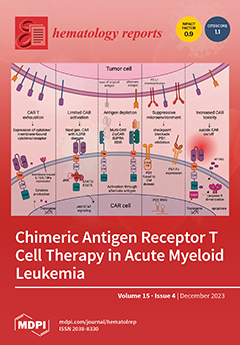Mantle cell lymphoma (MCL) is an intermediate-grade B-cell lymphoma, representing 2.8% of all non-Hodgkin lymphomas in the US. It is associated with t(11;14)(q13; q23), which leads to the overexpression of cyclin D1, consequently promoting cell proliferation. MCL usually expresses CD19, CD20, CD43, surface
[...] Read more.
Mantle cell lymphoma (MCL) is an intermediate-grade B-cell lymphoma, representing 2.8% of all non-Hodgkin lymphomas in the US. It is associated with t(11;14)(q13; q23), which leads to the overexpression of cyclin D1, consequently promoting cell proliferation. MCL usually expresses CD19, CD20, CD43, surface immunoglobulins, FMC7, BCL2, cyclin D1, CD5, and SOX11. Herein is a case of a 67-year-old male, referred to our facility with shortness of breath, anemia (hemoglobin of 5.3 g/dL), thrombocytopenia (12 × 10
9/L), and leukocytosis (283 × 10
9/L). A peripheral blood smear showed marked lymphocytosis with blastoid morphology. Morphologic examination of the bone marrow biopsy revealed a diffuse sheet of blastoid cells expressing CD20 and CD10, but without CD5 or cyclin D1. Given these features, a differential diagnosis of diffuse large B-cell lymphoma (DLBCL) with germinal center derivation, high-grade follicular lymphoma, and Burkitt lymphoma was considered, with the latter not favored due to morphology. Additional studies revealed positive SOX11, and fluorescence in situ hybridization (FISH) studies detected t(11;14). These additional studies supported diagnosis of the blastoid variant of MCL. In conclusion, we present a unique and challenging case of MCL without cyclin D1 or CD5, but with an expression of CD10 and SOX11, along with t(11;14). Pathologists should explicitly consider the blastoid variant of MCL when dealing with mature B-cell neoplasms with blastoid morphology in adults, and utilize a broad panel of ancillary studies, including FISH and SOX11.
Full article






